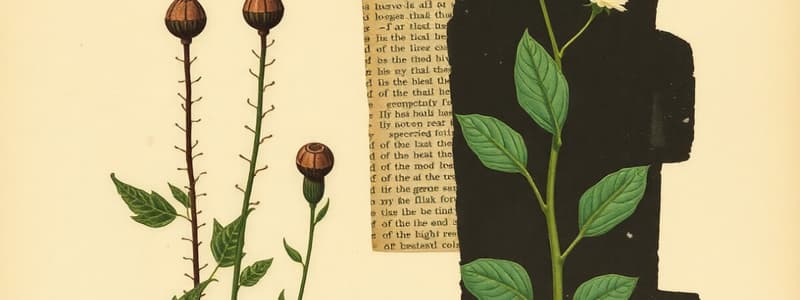Podcast
Questions and Answers
What structural feature distinguishes angiosperms from gymnosperms?
What structural feature distinguishes angiosperms from gymnosperms?
- Seeds are enclosed within a fruit (correct)
- Leaves are scale-like
- Naked seeds
- Lack of vascular tissue
What economic benefit does the flowering plant group provide?
What economic benefit does the flowering plant group provide?
- Medicinal compounds (correct)
- Only timber resources
- Stabilizing soils in deserts
- Enhancing boreal forests
Which characteristic is associated specifically with dicots?
Which characteristic is associated specifically with dicots?
- Mostly herbaceous plants
- Parallel leaf venation
- Vascular bundles arranged in a ring (correct)
- Single cotyledon
Which of the following is NOT a role of plants in the environment?
Which of the following is NOT a role of plants in the environment?
What is a defining characteristic of monocots?
What is a defining characteristic of monocots?
Which of the following is typically a characteristic of gymnosperms?
Which of the following is typically a characteristic of gymnosperms?
Why are gymnosperms considered ecologically important?
Why are gymnosperms considered ecologically important?
In terms of plant diversity, how do angiosperms rank among other plant groups?
In terms of plant diversity, how do angiosperms rank among other plant groups?
Which feature distinguishes angiosperms from gymnosperms?
Which feature distinguishes angiosperms from gymnosperms?
Why are dicots considered important in ecosystems?
Why are dicots considered important in ecosystems?
What role do flowering plants play in the environment?
What role do flowering plants play in the environment?
What characteristic of monocots sets them apart from dicots?
What characteristic of monocots sets them apart from dicots?
What is a significant economic use of flowering plants?
What is a significant economic use of flowering plants?
Which of the following is NOT a characteristic of gymnosperms?
Which of the following is NOT a characteristic of gymnosperms?
Which group do cycads belong to within gymnosperms?
Which group do cycads belong to within gymnosperms?
What does the term 'higher plants' refer to?
What does the term 'higher plants' refer to?
Which of the following characteristics is NOT associated with monocotyledons?
Which of the following characteristics is NOT associated with monocotyledons?
What is a key economic use of monocotyledons?
What is a key economic use of monocotyledons?
Which of the following is a correct example of a dicotyledon?
Which of the following is a correct example of a dicotyledon?
Which plant type is typically used for producing fibers for textiles?
Which plant type is typically used for producing fibers for textiles?
What role do wetland monocots, like cattails, play in the ecosystem?
What role do wetland monocots, like cattails, play in the ecosystem?
How do monocot species contribute to environmental stability?
How do monocot species contribute to environmental stability?
Which statement best describes the seed structure of dicotyledons?
Which statement best describes the seed structure of dicotyledons?
In which category do most flowering plants with parallel-veined leaves fall?
In which category do most flowering plants with parallel-veined leaves fall?
Flashcards are hidden until you start studying
Study Notes
Monocotyledons
- Commonly known as monocots, they are grass and grass-like flowering plants.
- Some examples include garlic, onions, wheat, corn, and grass.
- Monocot plants feature seeds with a single cotyledon, leaves with parallel veins, scattered vascular bundles in the stem, absence of a typical cambium, and an adventitious root system.
- Their flower parts are typically found in multiples of three.
- Monocot pollen grains have a single aperture (or furrow).
- They are significant for their nutritious grains and soil-forming functions globally.
- Examples of their important uses:
- Food: Rice, Wheat, Corn, Sugarcane, and other staple crops.
- Fiber: Cotton alternatives like Hemp and Sisal.
- Biofuels: Ethanol from Corn and Sugarcane.
- Timber: Bamboo and other monocot trees.
- Ornamentals: Lilies, Orchids, and other decorative flowers.
- They contribute significantly to the environment:
- Soil Stabilization: Extensive root systems prevent erosion.
- Water Filtration: Wetland monocots like Cattails filter water.
- Wildlife Habitat: Grasslands and wetlands support diverse ecosystems.
- Climate Regulation: Monocot forests influence local climate conditions.
Dicotyledons
- Also known as dicots, they are vascular plants that reproduce using flowers and have seeds with two cotyledons or seed leaves.
- Some examples are beans, cauliflower, apples, and pears.
- They are important for several reasons:
- Food: Beans, Peas, Lentils, Tomatoes, Potatoes, and many other edible crops.
- Timber: Oak, Maple, Mahogany, Teak, and other valuable wood-producing trees.
- Fiber: Cotton, Hemp, and Flax for textiles.
- Medicines: Digitalis (Foxglove), Quinine (Cinchona), and many pharmaceuticals.
Gymnosperms
- These plants bear seeds that are not enclosed within an ovary.
- They often have needle-like or scale-like leaves adapted for water conservation.
- Most are evergreen, keeping their foliage year-round.
- They reproduce using cones, male cones produce pollen, and female cones develop seeds.
- They play crucial roles in forest ecosystems:
- Ecological Importance: Conifer forests provide habitats and stabilize soils.
- Economic Importance: They are a source of timber, resins, and compounds used in the pharmaceutical industry.
- Gymnosperms can be found in boreal and temperate forests and deserts.
- The four main groups are:
- Coniferophyta (Conifers): Examples: Pine (Pinus spp.), Spruce (Picea spp.), Cedar (Cedrus spp.).
- Cycadophyta (Cycads): Example: Sago palm (Cycas revoluta).
- Ginkgophyta (Ginkgo): Example: Ginkgo biloba (the only extant species).
- Gnetophyta (Gnetophytes): Examples: Ephedra (used as a stimulant), Gnetum (tropical vines).
Angiosperms
- These are flowering plants whose seeds are contained within a fruit.
- They are the most diverse group of plants in terms of species and form.
- Angiosperms are vascular plants with stems, roots, and leaves.
- They are the dominant plant group on Earth.
- They can grow in various habitats as trees, herbs, shrubs, and bushes.
- Angiosperms are divided into two main groups: monocots and dicots.
Cotyledons
- The first seed leaf or one of the first leaves developed by the embryo of a seed plant.
- They are usually folded within the seed until germination and serve as a food source.
Spermatophyta (Seed Plants)
- They reproduce through seeds.
- They are most plants we see, ranging from trees and shrubs to small flowering plants.
- Seeds provide protection and nourishment for the developing embryo.
- These plants are also known as higher plants.
- The plant body is divided into a leaf, stem, and root.
- The majority are trees, shrubs, and some are herbaceous.
- Pollination is a crucial part of their sexual reproduction.
Gymnosperma
- They are seed-producing plants that do not form flowers or fruits.
- Their seeds are often exposed on cones or other structures.
- They are classified into four main groups: Coniferophyta, Cycadophyta, Ginkgophyta, and Gnetophyta.
Angiosperma
- They are also classed as higher plants.
- They are seed-producing plants that form flowers and fruits.
Studying That Suits You
Use AI to generate personalized quizzes and flashcards to suit your learning preferences.




